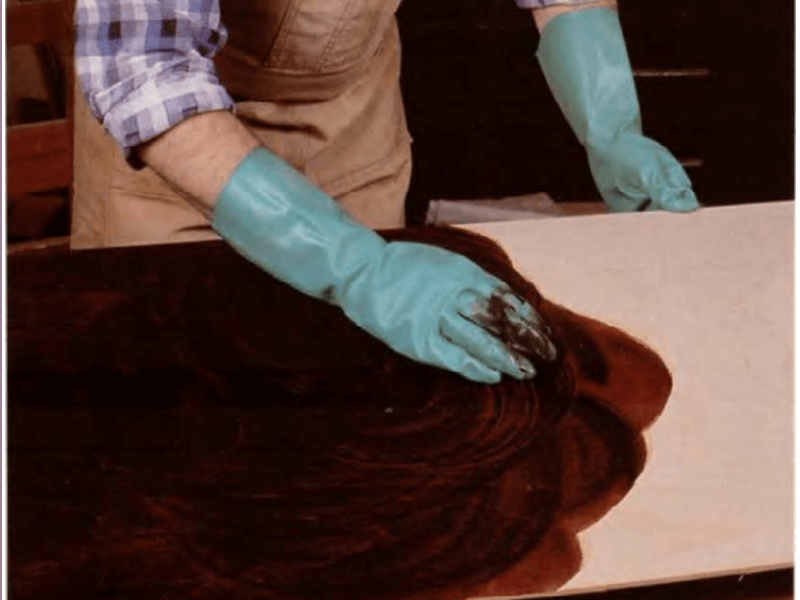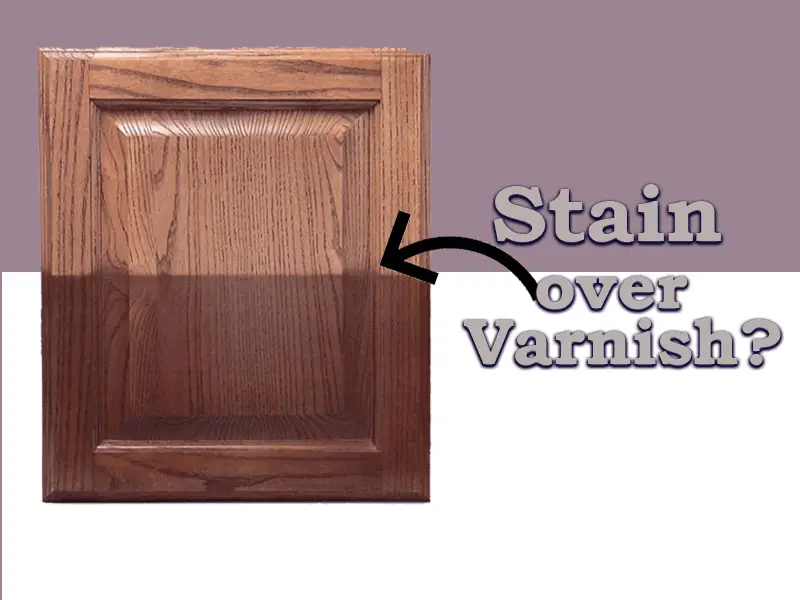In a recent post, we discussed staining over a polyurethane surface. We have since received some feedback and follow-up questions. Many would like to know, can you stain over varnish?
If you are looking for answers regarding staining varnish, you came to the right place. In this article, we will go over all the uncertainties surrounding staining a varnished surface.
Can you stain over varnish?
Sometimes we do not like the color of our wood and it’s ok since stains do remarkably well at toning, shading, or changing the color of the wood. With the right application of stain, you can turn a rather boring piece of wood into a rich-colored wood.
But what if the wood is coated with varnish? Can you stain on top of the varnish?
The answer is yes. Staining over varnish is workable and can produce pretty amazing finishes. The process of applying stain over a varnish coat is called glazing.
Do you have to remove the varnish before staining?
You may choose to remove the varnish before staining your wood. Should you choose this then the stain can be applied directly to the wood before resealing with varnish. However, this process may be cumbersome as it involves stripping the varnish first.
If the varnish is in a good state then you do not need to strip it off the wood before stain application.
As we shall see later on sanding can be necessary before staining as a precaution that ensures the surface is smooth and free of any imperfections.
Check out Painting over stained wood
Read Next
- Can You Stain Over Stain? Staining Explained
- Can You Stain Over Linseed Oil? Staining Oil Finish
- Can You Stain Over Shellac? Wood Sealing Basics
- How to Paint Wood: Step-by-Step Guide
- Types of Wood Stains: Staining 101
How do you stain already varnished wood?

The process of applying a stain to a varnished piece of wood is not as complicated as t may appear at first. In this section, we will break down the process into simple steps that are easy to follow.
Step one – surface prep
Preparing your surface before staining is important not only when the surface is varnished but even when we are just applying the stain directly to the wood. So what are the things to do in this first step?
Begin with sanding your varnish topcoat with 280 or finer grit sandpaper. Sanding will take care of any bumps and uneven sections that may be present.
Do not sand more than is needed remember we are going for a smooth surface, not a varnish-free surface.
Step two – stain application
After your surface is smooth and cleans the first coat of stain is ready to go on top of your varnish. Application of finishes including stains can be done in three major ways; using a brush, cloth, or spray system.
Choose a mode of application suitable for your project. If applying with a cloth spread the varnish to your varnish-coated wood and wipe off any excess.
When using a brush apply thinly and evenly to the entire surface. brush off any excess stain to make sure there are no brush marks left.
Step three – Let the stain cure
Once your stain is evenly spread on the surface you can let it cure overnight. But the drying time of a stain may vary read our article to know how to judge how long your particular stain will take to dry. After your stain has cured it’s time to protect it from scratches that can easily remove the tint we just added to our varnish-coated wood.
Step four – Add a protective layer
The protective layer should be your varnish. Vanish has no problem going on top of the stain. Whether the stain lays on the wood surface directly or is on top of varnish it can be protected by adding another coat of varnish. One layer should be enough if more staining is required otherwise normal varnish application procedure should be followed for a perfect, protective last layer.
step five – Analyze the results
The last step is to analyze the results of the last few steps. The main thing to check other than problems that may arise due to application missteps is whether the tone or shade we were going for is as intended.
Should you note that you need to tint your wood further then do not shy from reapplying the stain as guided from step two.
Can you darken varnished wood?

Darkening a wood that has a top varnish coat is possible. The procedure is the same as we have listed above for staining over varnish.
To darken the wood more coats of stain are needed. For the perfect results when attempting to darken a wood that is varnished to work gradually building layers of stain between varnish coats till a satisfactory result is achieved.
Just remember that the stain goes between the varnish coats. Do not sand the stain lest you remove the agent that is meant to darken your wood in the first place. Instead, sand each varnish layer as soon as it cures to ensure a smooth surface.
Also, a single coat of varnish between the stain is perfect to avoid building up a thick layer that brings about the plastic look we all hate.
What finish can be applied over varnish?
Once the varnish has cured there are quite a number of finishes that can very well go on top of the varnish. Some of the obvious ones are stains as we have discusses in this article.
Other finishes that will gladly sit on top of varnish are varnishes including polyurethane. Lacquer and shellac will also have no issues. The only requirement here is to make sure that the varnish is fully cured before adding a layer of another finish.
Can you stain over varnish without sanding?
Staining over varnish without sanding is possible but the surface has to be smooth and free from blemishes otherwise the result will fall short of a professional-looking finish.
Sanding is a process that is very crucial to finishing. Sanding not only helps in ensuring that the surface is nicely smooth and immaculate but it also etches the surface in preparation for staining. This better helps the stain hold on to the varnished surface.
However, the kind of sanding we are talking about here is very light. As stated before 280-grit sandpaper or higher should work well.
Remember that we are not trying to get read of the varnish coat when we sand but only making it ready to accept staining.
Recommended reading: Can you stain over shellac?
Can you stain over varnish – Summary
In summary, staining over varnish is possible. Glazing which is the craft of staining between layers of finishing can be a great way of staining a piece of wood without going through the trouble of stripping the varnish first.
To answer Can you stain over varnish this article has gone ahead to answer and illustrate the process of staining over varnish.
We hope that we touched up on all concerned areas and that now the process of staining is much easier. If you still have further questions let us know in the comments and we will be glad to assist.
